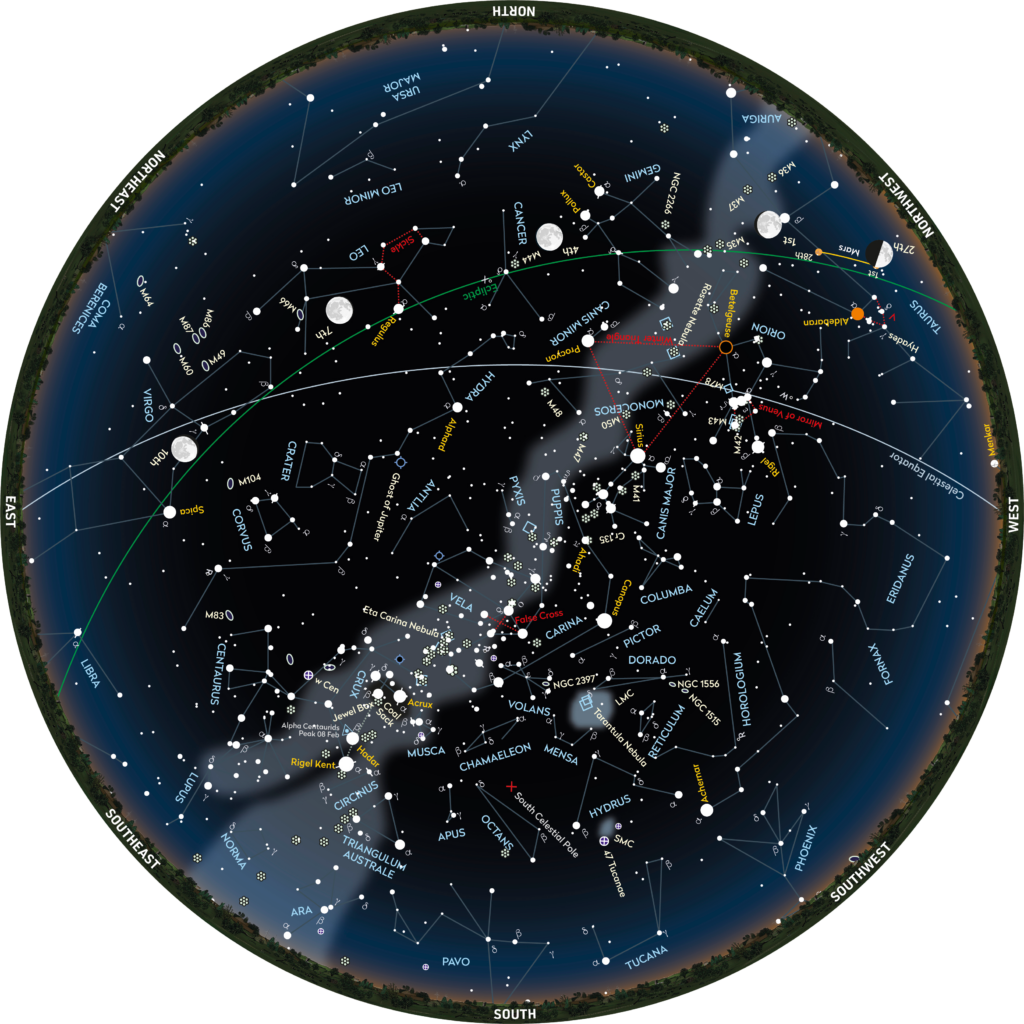Bright Venus and Jupiter hang out together all month, and we visit two galaxies in Dorado


When to use this chart
1 Feb at 00:00 AEDT (13:00 UT)
15 Feb at 23:00 AEDT (12:00 UT)
28 Feb at 22:00 AEDT (11:00 UT)
The chart accurately matches the sky on the dates and times shown for Sydney, Australia. The sky is different at other times as the stars crossing it set four minutes earlier each night.
FEBRUARY HIGHLIGHTS
Recommended equipment: Naked eye
This month, a spectacular naked-eye sight: a conjunction between Venus and Jupiter. Brilliant Venus is low in the western evening sky, with Jupiter to its upper right, their distance closing. They both outshine any star, with the crescent Moon chiming in on the 22nd just 1° from Venus – a pretty sight! The following evening they are 12° apart, forming a line with Jupiter in the centre. The month concludes with the planets separated by 2°, closing to only 0.5° on 2 March.
STARS AND CONSTELLATIONS
Recommended equipment: Naked eye
Alpha Canis Majoris (Sirius) forms a near perfect equilateral triangle with two other bright alpha stars, Procyon (in Canis Minoris) and Betelgeuse (in Orion). These make up the ‘Winter Triangle’. The two ‘Canis’ constellations represent Orion the Hunter’s dogs. Although Sirius looks the brightest, that is only because it is 8.5 lightyears away. Red supergiant Betelgeuse is 500 lightyears distant. If it matched Sirius’s distance, it would glow as bright as a first quarter Moon!
THE PLANETS
Recommended equipment: Naked eye
The beacon of Venus can’t be missed as it slowly crawls out of the western twilight sky. It is passed by Neptune midmonth (0.2° apart on 15th) and Jupiter at month’s end, as both are swallowed by the twilight glow, heading for conjunction.
Mars is now well-placed in the early, northern evening sky. With the Red Planet departing around midnight, there is a dearth of planets until Mercury appears in the eastern pre-dawn sky. Its favourable morning apparition ends as February ends.
DEEP–SKY OBJECTS
Recommended equipment: Large telescope
This month, a trip to the far south to visit two very different galaxies in the constellation of Dorado. Beginning at Alpha Doradus, 2° west lies the face-on spiral NGC 1566 (RA 4h 20.0m, dec. –54° 56’). At 9th magnitude, it has a bright 2-arcminute core with a condensed nucleus. It is surrounded by a diffuse, mottled halo (5 arcminutes). A 20cm instrument reveals two distinctive spiral arms, where it gets its name, ‘the Spanish Dancer’. There is a prominent 8th-magnitude star 6 arcminutes northwest.
Move a further 2.5° west to discover the edge-on spiral NGC 1515 (RA 4h 04.0m, dec. –54° 06’). In contrast to NGC 1566, this 11th-magnitude galaxy is highly elongated in shape (3.5 x 0.5 arcminutes) with an even illumination. Very large instruments (around 254cm) show some brightening in the centre.